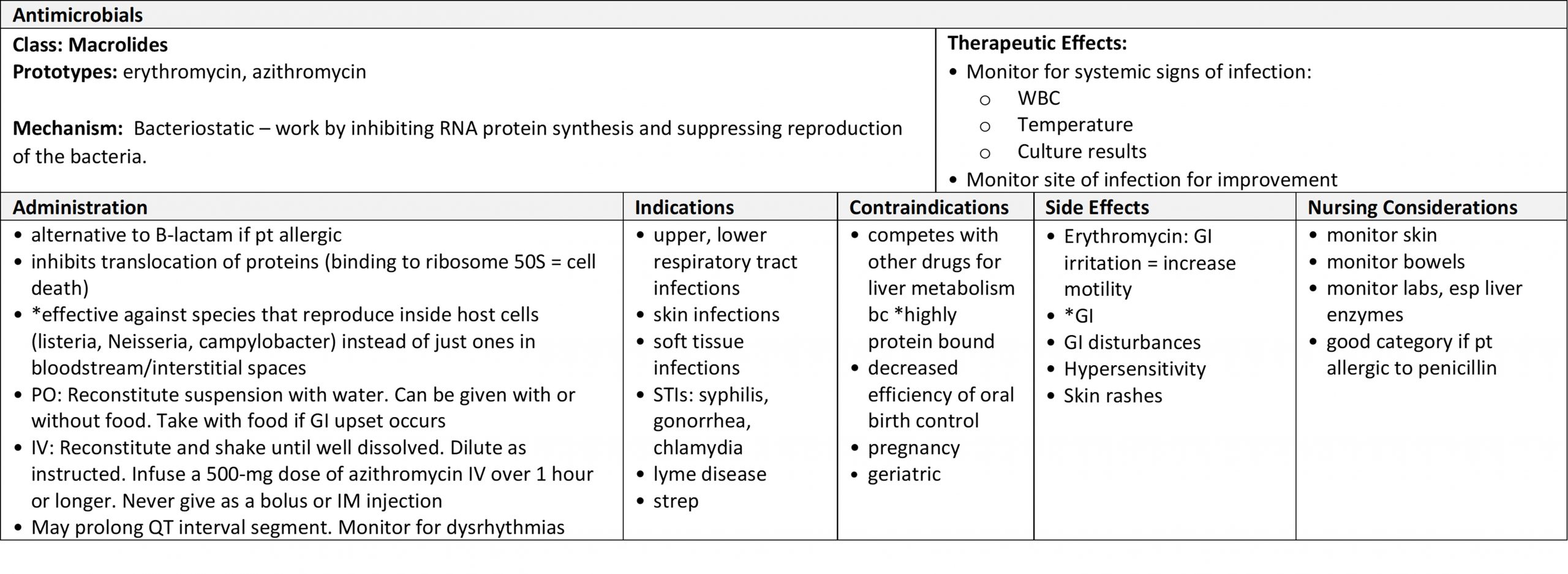Antimicrobials
3.12 Macrolides
Open Resources for Nursing (Open RN)
Macrolides are complex antibacterial broad-spectrum medications that are effective against both gram-positive and gram-negative bacteria.
Mechanism of Action: Macrolides inhibit RNA protein synthesis and suppress reproduction of the bacteria. Macrolides are bacteriostatic as they do not actually kill bacteria, but inhibit additional growth and allow the body’s immune system to kill the offending bacteria.[1]
Indications for Use: Macrolides are often used for respiratory infections, otitis media, pelvic inflammatory infections, and Chlamydia.
Nursing Considerations Across the Lifespan: Macrolides are safe for use across the lifespan, including in pregnancy and with pediatric clients.
Specific Administration Considerations: Macrolides can have significant impact on liver function and should be used cautiously in clients with liver disease or impairment.
Patient Teaching & Education: GI upset is common and clients can be advised to take medication with food. Clients should also be advised to avoid excessive sunlight and to wear protective clothing and use sunscreen when outside, as well as to report any adverse reactions immediately. Advise clients to report symptoms of chest pain, palpitations, or yellowing of eyes or skin. Additionally, clients should be advised that these medications can cause drowsiness.[2]
Now let’s take a closer look at the medication card for erythromycin and azithromycin in Table 3.11.[3][4] Because information about medication is constantly changing, nurses should always consult evidence-based resources to review current recommendations before administering specific medication.
Table 3.11 Macrolides Medication Card
Class: Macrolides (prototypes: erythromycin, azithromycin)

Clincal Reasoning and Decsion-Making Activity 3.11a
Using the above information, consider the following clinical scenario question:
A nurse is administering azithromycin to a client with an acute bacterial worsening of COPD. Today the client’s sclera appear yellow, which is a new finding. What is the nurse’s next best response?
Note: Answers to the activities can be found in the “Answer Key” sections at the end of the book.
Media Attributions
- macrolides
- This work is a derivative of Microbiology by OpenStax licensed under CC BY 4.0. Access for free at https://openstax.org/books/microbiology/pages/1-introduction ↵
- uCentral from Unbound Medicine. https://www.unboundmedicine.com/ucentral ↵
- Daily Med, https://dailymed.nlm.nih.gov/dailymed/index.cfm, used for hyperlinked medications in this module. Retrieved June 28, 2019. ↵
- UpToDate (2021). Erythromycin. https://www.uptodate.com/contents/search ↵

